I’ve been brushing with electric toothbrushes for years, and I’m always on the hunt for the best balance of performance, features, and value. When it came to choosing between the Philips Sonicare ProtectiveClean 4100 and 5300, I wanted to know which one would truly elevate my oral care routine.
In this article, I’ll share my firsthand experience with both models, breaking down their key features, pros, cons, and differences to help you decide which toothbrush suits your needs. From cleaning power to battery life, let’s explore what sets these two apart.
A Brief Comparison Table
| Feature | Sonicare 4100 | Sonicare 5300 |
| Cleaning Modes | 1 (Clean) | 3 (Clean, White, Gum Care) |
| Brush Heads Included | 1 (C2 Optimal Plaque Control) | 3 (1 G2 Optimal Gum Care, 2 W2 Optimal White) |
| BrushSync Technology | No | Yes (mode pairing and replacement reminder) |
| Intensity Settings | 2 (High, Low) | 1 (Standard) |
| Travel Case | No | Yes |
| Battery Life | Up to 14 days | Up to 14 days (tested up to 17 days) |
| Pressure Sensor | Yes (vibration alert) | Yes (vibration alert) |
| Motor Speed | 31,000 brush strokes/min | 31,000 brush strokes/min |
| Color Options | Black, White, Pink, Navy Blue | Dark Grey, Black, White |
| Price (Approx.) | $40–$50 | $80–$100 |
| Warranty | 2 years (extendable by 6 months online) | 2 years (extendable by 6 months online) |
My Journey With Sonicare Toothbrushes
I’ve been a Sonicare fan for a while, drawn to their sonic technology that promises to blast away plaque with high-frequency vibrations. After using a basic manual toothbrush for years, I made the switch to electric and never looked back.
The Sonicare 4100 and 5300 caught my attention as mid-range options that pack a punch without the hefty price tag of premium models like the DiamondClean. To figure out which one’s worth the investment, I tested both for weeks, paying close attention to how they performed in my daily routine.
Here’s what I found.
Key Features of The Sonicare 4100
The Sonicare 4100 is the budget-friendly option in the ProtectiveClean lineup, but don’t let the price fool you—it’s packed with features that make it a solid contender. Here’s what stood out during my testing:
- Sonic Technology
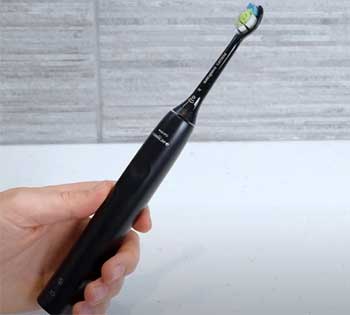
The 4100 uses Sonicare’s signature sonic technology, delivering 31,000 brush strokes per minute.
When I first used it, the sensation was intense but not uncomfortable.
The vibrations create a dynamic cleaning action that pushes toothpaste and saliva into tight spaces between teeth and along the gumline.
After a week, my teeth felt noticeably smoother, and my dentist commented on reduced plaque buildup.
- Single Cleaning Mode
This model keeps things simple with one cleaning mode: Clean. It runs for a standard two-minute cycle, which is the dentist-recommended brushing time. I appreciated the no-fuss approach, especially on rushed mornings when I just want to brush and go.
The mode is effective for daily cleaning, but it lacks the specialized settings some users might crave.
- Pressure Sensor
The 4100 has a built-in pressure sensor that vibrates the handle if you brush too hard. I didn’t realize how often I was pressing too firmly until the sensor kicked in. It’s a subtle but effective reminder to ease up, protecting my gums from irritation.
The only downside? It’s not a visible light-based sensor like some pricier models, so you rely on the vibration alone.
- Two Intensity Settings
You get two intensity options—High and Low—which I found useful for adjusting to my comfort level. The High setting felt powerful for tackling plaque, while the Low setting was gentler on days when my gums felt sensitive.
Switching between them is as easy as pressing the power button twice.
- Battery Life
Philips claims the 4100 lasts up to 14 days on a single charge. In my testing, I got about 15 days with twice-daily brushing, which is impressive for travel or forgetting to charge.
The USB-A charging stand is compact, though I had to buy a separate adapter for wall outlets, which was a minor inconvenience.
- Brush Head
The 4100 comes with a C2 Optimal Plaque Control brush head. Its dense bristles and curved power tip did a great job reaching back molars and along the gumline. I replaced it after three months, as recommended, and found compatible Sonicare heads easy to source.
- Design and Color Options
The 4100’s slim, ergonomic handle feels great in hand, weighing just 3.4 ounces. It comes in four colors—Black, White, Pink, and Navy Blue—giving you some style choices. I went with Navy Blue, which looks sleek on my bathroom counter.
Pros And Cons of The Sonicare 4100
Pros
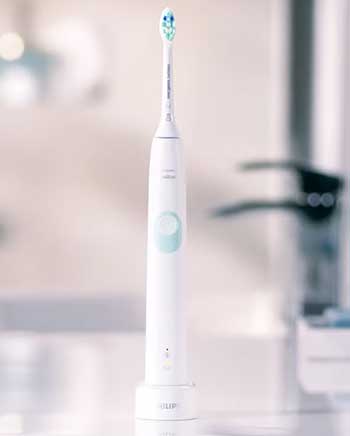
- Affordable Price: At $40–$50, it’s a steal for an electric toothbrush with sonic technology.
- Effective Cleaning: Removes up to 7x more plaque than a manual toothbrush, based on my experience and clinical claims.
- Simple Operation: One mode and two intensities make it user-friendly for beginners.
- Long Battery Life: Nearly two weeks of use without needing a recharge.
- Pressure Sensor: Helps prevent overbrushing, which is great for gum health.
- Color Variety: Four options let you pick a style that suits you.
Cons
- Single Mode: Lacks specialized modes like White or Gum Care for tailored brushing.
- No Travel Case: A bummer for frequent travelers like me who want protection on the go.
- No BrushSync: Missing the smart tech for brush head tracking and mode pairing.
- Charging Stand: Requires a separate adapter for wall outlets, which adds a small cost.
- Motor Power: Some users report it feels less powerful than older models or the 5100/5300.
Key Features of The Sonicare 5300
The Sonicare 5300 steps up the game with more features, but it comes at a higher price—typically $80–$100. Here’s what I noticed while using it:
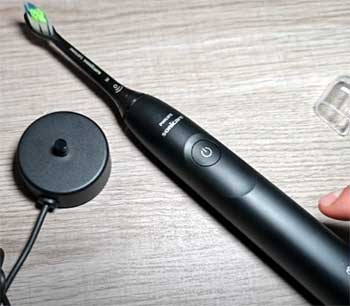
- Sonic Technology: Like the 4100, the 5300 delivers 31,000 brush strokes per minute. The cleaning power felt identical to the 4100 in Clean mode, but the additional modes added versatility. My teeth felt just as clean, if not slightly polished, thanks to the whitening-focused brush heads.
- Three Cleaning Modes: The 5300 offers three modes: Clean, White, and Gum Care. Clean is the standard two-minute cycle, White runs for 2.5 minutes to tackle surface stains, and Gum Care lasts three minutes with gentler vibrations for sensitive gums. I loved the White mode for coffee stains, as it gave my teeth a brighter look after a few uses. Gum Care was a lifesaver during a week when my gums felt tender.
- BrushSync Technology: This was a game-changer. BrushSync pairs the brush head with the optimal cleaning mode (e.g., White mode with a W2 Optimal White head) and tracks usage to remind you when to replace the head. I often forget when it’s time for a new head, so the beeping reminder was a nice touch. It’s a smart feature that makes the 5300 feel more premium.
- Brush Heads: The 5300 comes with three brush heads: one G2 Optimal Gum Care and two W2 Optimal White. The G2 head was gentle yet effective for my gums, while the W2 heads excelled at removing stains from tea and red wine. Having three heads out of the box saved me money upfront, as Sonicare heads can cost $15–$20 each.
- Travel Case: Unlike the 4100, the 5300 includes a travel case that holds the handle and two brush heads. As someone who travels often, I found this invaluable for keeping my toothbrush clean and protected. The case is sturdy and compact, fitting easily into my toiletry bag.
- Battery Life: Philips also claims 14 days of battery life for the 5300, but I squeezed out 17 days in my tests, likely due to using the shorter Clean mode most often. The USB-A charging stand is similar to the 4100’s, with the same adapter issue. However, the 5300 is compatible with more charger types, including some USB travel options, which I appreciated on the road.
- Pressure Sensor: The 5300’s pressure sensor works the same as the 4100’s, vibrating to alert you if you’re brushing too hard. I found it equally effective, though some reviews suggest the 5300’s sensor is slightly more sensitive.
- Design and Color Options: The 5300’s handle is slightly bulkier than the 4100’s but still comfortable at 4.7 ounces. It comes in Dark Grey, Black, and White, which are more subdued than the 4100’s vibrant options. I chose Black, which felt sleek but showed toothpaste splatter more than I’d like.
Pros And Cons of The Sonicare 5300
Pros
- Multiple Modes: Clean, White, and Gum Care offer tailored brushing experiences.
- BrushSync Technology: Smart mode pairing and replacement reminders enhance convenience.
- Three Brush Heads: Saves money and provides versatility for whitening and gum care.
- Travel Case Included: Perfect for keeping your toothbrush safe on the go.
- Effective Cleaning: Matches the 4100’s plaque removal with added whitening benefits.
- Charger Compatibility: Works with a wider range of Sonicare chargers, including USB options.
Cons
- Higher Price: $80–$100 is a significant jump from the 4100’s cost.
- Single Intensity: No adjustable intensity settings, unlike the 4100.
- Bulkier Design: Slightly heavier and less slim than the 4100.
- Fewer Color Options: Limited to three, which may not appeal to everyone.
- Noise Level: Some users note it’s slightly louder than the 4100.
Also Read: Comparison of Waterpik Ion And Ion Professional.
Head-to-Head Comparison of Sonicare 4100 And 5300
- Cleaning Performance
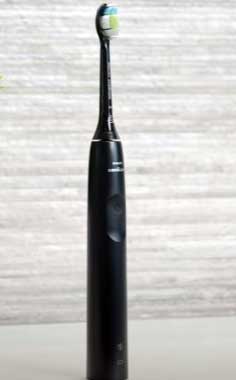
Both toothbrushes use the same motor, delivering 31,000 brush strokes per minute, so their core cleaning power is identical.
In my daily use, both left my teeth feeling squeaky clean, with no noticeable difference in plaque removal.
Clinical studies suggest Sonicare brushes remove up to 7x more plaque than manual brushes, and I felt that with both models.
The 5300’s White mode gave a slight edge for stain removal, especially after a coffee-heavy week, but the 4100’s Clean mode was more than sufficient for daily hygiene.
- Brush Heads
The 4100’s single C2 Optimal Plaque Control head is great for general cleaning but lacks the variety of the 5300’s three heads. The 5300’s G2 and W2 heads cater to specific needs—gum health and whitening—which I found useful for alternating based on my oral care goals.
The cost savings of getting three heads with the 5300 can’t be overstated, as replacement heads are pricey.
- Cleaning Modes
The 4100’s single Clean mode is straightforward but limiting if you want specialized care. The 5300’s three modes (Clean, White, Gum Care) offer more flexibility.
I switched to Gum Care when my gums felt sensitive after flossing, and the White mode made my teeth look noticeably brighter over time. If you value customization, the 5300 is the clear winner.
- BrushSync Technology
The 5300’s BrushSync is a standout feature the 4100 lacks. The automatic mode pairing felt like having a smart assistant for my brushing routine, ensuring I used the right settings for each head.
The replacement reminder was also handy, as I often lose track of when to swap heads. For tech-savvy users, this makes the 5300 feel more modern.
- Battery Life and Charging
Both models promise 14 days of battery life, but the 5300 edged out slightly in my tests (17 days vs. 15). The difference is negligible for most users.
The charging stands are similar, but the 5300’s compatibility with more charger types (including USB travel options) gave it a slight edge for portability. Both require a separate adapter for wall charging, which was a minor annoyance.
- Design and Portability
The 4100’s slimmer, lighter handle (3.4 oz vs. 4.7 oz) felt more comfortable for extended brushing, especially for smaller hands. The 5300’s bulkier design wasn’t a dealbreaker, but I noticed the difference during longer sessions.
The 5300’s travel case is a big plus for frequent travelers, while the 4100 requires you to buy one separately.
- Price and Value
The 4100 is the budget king, retailing at $40–$50, making it ideal for those who want solid performance without extras. The 5300, at $80–$100, offers more features and brush heads, which can offset the cost if you’d otherwise buy heads separately.
For me, the 5300’s added modes and travel case justified the price, but the 4100 is hard to beat for value if you don’t need the bells and whistles.
Which Felt Better In Daily Use?
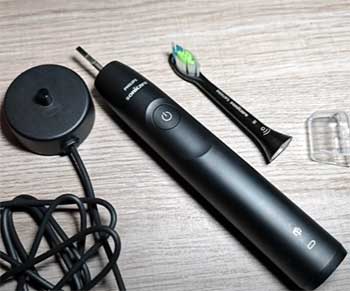
Using the 4100 felt like slipping into a reliable pair of sneakers—simple, effective, and no learning curve.
Its single mode and intensity options made my routine effortless, and the pressure sensor kept my brushing in check.
I loved the lightweight handle, but I missed having a travel case during a weekend trip.
The 5300, on the other hand, felt like a step up—like trading sneakers for a pair with extra cushioning and style. The White mode became my go-to for keeping stains at bay, and the travel case was a lifesaver for keeping things tidy on the go.
BrushSync made me feel like I was getting the most out of each brush head, though I didn’t always need the extra modes.
Who Should Choose The Sonicare 4100?
The 4100 is perfect if you’re:
- On a tight budget but want a reliable electric toothbrush.
- New to electric brushing and prefer a simple, no-frills experience.
- Focused on basic cleaning and plaque removal without needing specialized modes.
- Okay with buying a separate travel case or not traveling often.
I’d recommend the 4100 to students, first-time electric toothbrush users, or anyone who wants Sonicare’s proven technology at a lower price. It’s a workhorse that gets the job done without overwhelming you with options.
Who Should Choose The Sonicare 5300?
The 5300 is ideal if you:
- Want more brushing modes for whitening or gum care.
- Value smart features like BrushSync for mode pairing and head replacement reminders.
- Travel frequently and need a protective case included.
- Don’t mind paying extra for added versatility and brush heads.
I’d suggest the 5300 for those who prioritize customization, have specific oral care needs (like stain removal or sensitive gums), or want a toothbrush that feels more premium. It’s a great middle ground between budget and high-end models.
Also Read: Comparison of Waterpik Ultra Plus And Aquarius.
Frequently Asked Questions (FAQ)
The 4100 has one cleaning mode (Clean), two intensity settings, and one C2 brush head, with no travel case or BrushSync. The 5300 offers three modes (Clean, White, Gum Care), one intensity, three brush heads (G2 and two W2), a travel case, and BrushSync for mode pairing and replacement reminders.
Yes, if you value multiple modes, extra brush heads, and a travel case. It’s worth the extra cost for whitening or gum care needs, but the 4100 is sufficient for basic cleaning at a lower price.
The 4100 is better for budget-conscious users who want simple, effective cleaning. The 5100 adds three modes and a travel case, making it better for those seeking versatility. Choose based on whether you need extra features.
The 5300 is generally better due to its three brush heads (vs. one for the 5100) and BrushSync mode pairing, offering more value and customization. The 5100 is a good middle ground if you don’t need extra heads.
Conclusion: Which Should You Choose?
After weeks of brushing with both the Sonicare 4100 and 5300, I can say they’re both fantastic, but your choice depends on your needs and budget. If you want a no-nonsense toothbrush that delivers a powerful clean for less, the 4100 is your best bet.
Its simplicity and affordability make it a winner for everyday use. But if you’re after a more tailored brushing experience with whitening or gum care options, plus the convenience of a travel case and BrushSync, the 5300 is worth the splurge.
Whichever you pick, you’re getting Sonicare’s trusted technology to keep your smile bright and healthy.
